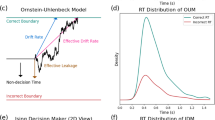Abstract
Economic theories of choice under uncertainty assume that agents act as if they have preferences which govern their choices between risky options. Theories differ as to the exact specification of the preference structure, but it is common to assume that preferences are complete and satisfy certain consistency requirements such as transitivity and monotonicity. In this paper, it is argued that there may be reason to doubt whether individuals act as if they have complete and consistent preferences over risky actions. Instead it is suggested that individuals should be thought of as actively constructing preferences through a process which I call “rationalisation”. It is then argued that rationalisation provides a basis for understanding certain experimentally observed “anomalies” which appear quite at odds with conventional theory.
Similar content being viewed by others
References
Aronson E (1992) The social Animal. 6th edn. Freeman, San Francisco
Berg J, Dickhaut J O'Brien (1985) Preference reversal and arbitrage. In Smith V (ed.) Research in Experimental Economics. JAI press, Greenwich 3: 3172
Cooper J, Fazio RH (1984) A new look at dissonance theory. Adv Exp Soc Psychol 17: 229–266
Festinger L (1957) A Theory of Cognitive Dissonance. Row Peterson, Evanston, IL
Grether I, Plott C (1979) Economic theory of choice and the preference reversal phenomenon. Am Econ Rev 69: 623–638
Hausman DM (1992) The Inexact and Separate Science of Economics. Cambridge University Press, Cambridge
Holt CA (1986) Preference reversals and the independence axiom. Am Econ Rev 76: 508–515
Kahneman D, Tversky A (1979) Prospect theory: An analysis of decision under risk. Econometrica 47: 263–291
Karni E, Safra Z (1987) “Preference Reversal” and the observability of preferences by experimental methods. Econometrica 55: 675–685
Lichtenstein S, Slovic P (1971) Reversals of preference between bids and choices in gambling decisions. J Exp Psychol 89: 46–55
Lindman H (1971) Inconsistent preferences among gambles. J Exp Psychol 89: 390–397
Loomes G, Sugden R (1987) Some implications of a more general form of regret theory. J Eco Theory 41: 270–287
Loomes G, Starmer C, Sugden R (1989) Preference reversal: information-processing effect or rational non-transitive choice? Econ J 99: 140–151
Loomes G, Starmer C, Sugden R (1991a) Observing violations of transitivity by experimental methods. Econometrica 59: 425–441
Loomes G, Starmer C, Sugden R (1991b) Are preferences monotonic? Testing some predictions of regret theory. Economica 59: 17–33
Machina M (1982) “Expected utility” theory without the independence axiom. Econometrica 50: 277–323
March JG (1978) Rationality, ambiguity, and the engineering of choice. Bell J Econ 9: 587–608
Pommerehne W, Schneider F, Zweifel P (1982) Economic theory of choice and the preference reversal phenomenon: a reexamination. Am Econ Rev 72: 569–574
Quiggin J (1982) A theory of anticipated utility. J Econ Behav Organ 3: 323–343
Reilly R (1982) Preference reversal: further evidence and some suggested modifications in experimental design. Am Econ Rev 72: 576–584
Rubinstein A (1988) Similarity and decision-making under risk. J Econ Theory 46: 145–153
Segal U (1988) Does the preference reversal phenomenon necessarily contradict the independence axiom? Am Econ Rev 78: 233–236
Selten R (1990) Bounded rationality. J Inst Theore Econ 146: 649–658
Simon HA (1957) Models of Man. Wiley, New York
Starmer C (1992) Cycling with rules of thumb: an experimental test for a new form of non-transitive behaviour. Economics Research Centre Discussion Paper, University of East Anglia, Norwich, England
Tversky A, Kahneman D (1981) The framing of decisions and the psychology of choice. Science 211: 453–458
Tversky A, Kahneman D (1986) Rational choice and the framing of decisions. J Business 59: S.251–278
Tversky A, Thaler RH (1990) Anomalies: preference reversal. J Econ Perspectives 4: 201–211
Yaari M (1987) The dual theory of choice under risk. Econometrica 55: 95–115
Author information
Authors and Affiliations
Rights and permissions
About this article
Cite this article
Starmer, C. Explaining risky choices without assuming preferences. Soc Choice Welfare 13, 201–213 (1996). https://doi.org/10.1007/BF00183351
Received:
Accepted:
Issue Date:
DOI: https://doi.org/10.1007/BF00183351




